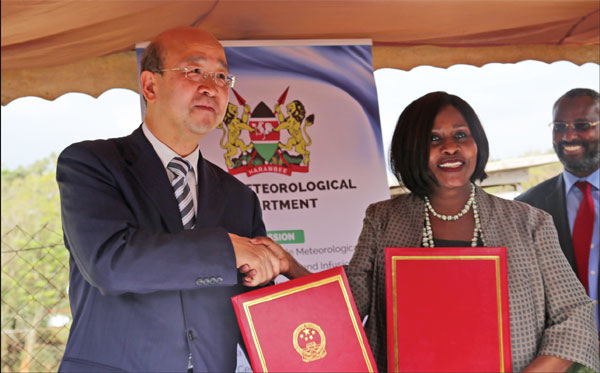China aids Kenya's weather forecasting

AWS system seen as key to helping country meet flagship Vision 2030 goal
Kenya's efforts to modernize its meteorological services so it can receive accurate and timely observation data have received a boost with the gift of automatic weather systems from the Chinese government.
The systems have been installed in Nairobi, Baringo, Elgeyo-Marakwet, Nandi and Nyamira counties. The stations continuously collect weather data and relay it to a base station at the headquarters of the Kenya Meteorological Department in Nairobi.
According to Cabinet Secretary Judi Wakhungu, of the Ministry of Environment and Natural Resources, the AWS will spread across the country and work with 72 others that were acquired by the government.
| Chinese Ambassador to Kenya Liu Xianfa (left) and Kenya's Secretary for Environment and Natural Resources Judi Wakhungu at the handover ceremony for automatic weather stations in Nairobi, Kenya, on Sept 11. Edith Mutethya / China Daily |
"Real-time data is aggregated from the AWS at 10-minute intervals as opposed to manual observations, which are made hourly. Hence, it will improve weather forecasting," she says, adding that two of the stations have the ability to detect lightning.
AWS is a monitoring station equipped with different sensors capable of measuring weather parameters including wind speed and direction, air temperature, humidity, radiation, air pressure and rainfall.
The data are set wirelessly through the cellular network as text messages or using a short messaging system.
Wakhungu says the close working relationship between Kenya and China over the years in various areas of development has assisted the East African country in moving toward providing quality world-standard services to its people.
Samuel Mwangi, a meteorologist from the KMD, expressed gratitude to the Chinese government for contributing to the department's further understanding of weather systems.
"Unlike manual systems, where everything is done by hand, from observation to data transmission - which allows room for error - AWS transmits data automatically to the central forecasting office for application. It's more accurate," he says.
Noting that most natural disasters in Kenya are weather-related or tied to climate, Mwangi says the accurate monitoring will help in disaster prediction and prevention.
Mwangi notes that an AWS station is designed to be rugged and standalone, so it can be deployed even in the harshest remote areas and can operate continuously, as it gets power from the sun, backed up by an internal rechargeable battery.
"AWS will play a great role in helping us get data from areas where we couldn't install manual stations because of security issues," he says.
S.G Kiama, principal of the College of Agriculture and Veterinary Sciences, where the Nairobi station is located, says he is grateful for the AWS because it is relevant for academic research, teaching and community service.
"Our lecturers can easily access the station when they want to give illustrations to students. Students on the other hand, are able to get data for free in order to be able to write good theses," he says.
Stephen Njoroge of the World Meteorological Organization says the AWS is a remarkable development for the country in terms of weather forecasting.
"With this kind of technology, KMD is on another level of development. It will now be able to enhance its weather forecasts and agricultural data in a faster and more accurate manner," he says
Liu Xianfa, the Chinese ambassador to Kenya, says the installation of the AWS has paved the way for a strengthened partnership between China and Kenya in areas of meteorology, agriculture and climate change.
"I firmly believe that, under the strong leadership of the ministry - and with the continued support and intensive training provided by the Chinese side, as well as unremitting efforts by the KMD - this modern system will make great contribution to the implementation of the Modernization of Meteorological Services flagship project of Kenya's Vision 2030," he says. "This is in addition to improving Kenya's ability to implement the Global Framework of Climate Services initiated by the World Meteorological Organization."
The modernization project was stirred by the increased need for weather information in the country coupled with a decrease in human resources available for weather observation.
Through the program, the KMD is modernizing its infrastructure - observation equipment, data and product transmission facilities and systems, data analysis and processing systems and product dissemination systems. The Chinese donation is part of the project.
edithmutethya@chinadaily.com.cn
(China Daily Africa Weekly 09/15/2017 page28)
Today's Top News
- Ukraine crisis a lesson for the West
- Autonomous networks driving the progress of telecom sector
- China launches cargo drone able to haul up to 1.2 tons
- Key role of Sino-German ties stressed
- Tariffs hurt global trade: Experts
- Rescuers race against time to find survivors































